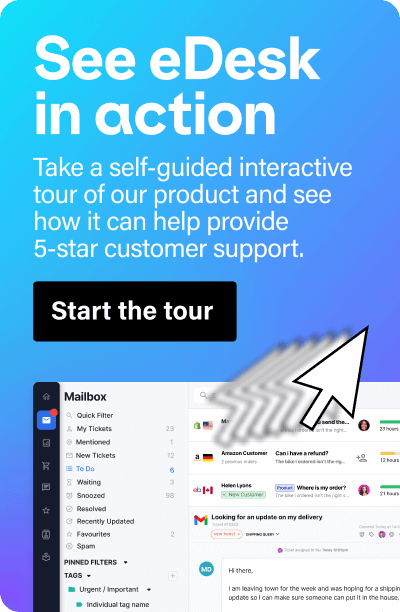Vacations used to be really simple when you were still in the corporate world. You’d put in for some time off, enjoy yourself guilt-free, and come back to a mountain of emails. But with selling on Amazon, treating yourself to a vacation isn’t as cut-and-dry as it used to be.
You’re now in charge of everything and are responsible for making sure everything operates smoothly while you’re away. Luckily, with a bit of help from eDesk and some handy options on Amazon, you can go back to taking some much-deserved time off and hardly miss a beat.
The Key to a Successful Vacation is Preparing Beforehand
As we said before, booking a vacation is easier when you’re a small cog in a large corporate wheel, but the whole axle doesn’t have to come apart now that you’re an Amazon seller. All that’s required is being more methodical with your planning ahead of time.
If you sell via Fulfilled by Merchant (FBM), you’ll need to activate vacation mode on your listings, but if you sell via Fulfilled by Amazon (FBA), then your orders will go ahead as usual and you’ll only need to plan ahead for inventory management during your time off (make sure you’re using the right inventory management tools to keep things running smoothly).
Before you change your Amazon vacation settings on your listings, go over this checklist first so that flipping the switch is a simple, no-thought process.
1. Make Sure All Pending Orders are Fulfilled
Buyers don’t care that you’re on vacation and won’t find that an acceptable reason to wait on their purchases until you get back, so make sure all pending orders are fulfilled first. Once you do that, you’ll be clear to inactivate your listings, but doing so doesn’t automatically cancel pending orders — they’ll still be there, waiting to be fulfilled.
2. Write an Automatic Reply for Messages
If you’re not using a help desk software such as eDesk for automating responses to stay within your SLAs, then ensure you follow all steps for enabling Vacation mode. Not responding to customer questions can hurt your seller metrics, so it’s better to have a template response that goes out automatically when you’re away. It doesn’t have to be anything long or terribly detailed, just a simple message that lets customers know you’re away and for how long so they can understand when they’ll be able to place orders again.
3. Inactivate Listings with Plenty of Notice
The last step in the process is changing your listings to inactive so that customers can’t place orders. You’ll want to give yourself at least two days to do this. If you change them with less than 48 hours to go, you’re risking getting orders that you’ll have to fulfil that could cut into your vacation time. But if you change them to inactive too many days ahead of time, you could be losing out on orders that could very easily be fulfilled before you go away.
The Work Doesn’t Quite Stop When You’re Actually on Vacation
Unfortunately, you’ll have to check your account a little bit while you’re away or assign that task to someone trustworthy and reliable.
The biggest check-in that’ll have to be done is responding to buyers within 24 hours so that you can maintain good seller account metrics, as Amazon requires you to provide them with an answer within that timeframe.
If you’ve opted to do this yourself, make sure your staff know about this. Amazon can suspend your account if it sees too many logins from multiple devices, so either have your staff stick to logging in on their work computers or make sure you’re using the same phone or laptop on the same IP address.
Whichever decision you go with, getting back to customers within that 24-hour window really goes a long way toward protecting your brand’s reputation as an active and engaging one, and maintaining its value even while not accepting and fulfilling orders.
You Can Reduce the Amount of Work on Vacation By Automating Processes
Although you’ve set your listings to inactive, you still have the option to keep things going a bit by automating certain things.
One of those is creating and editing listings, which will take effect once they’ve been set to active when you decide they’re — and you’re — ready.
Another is responding to claims or complaints. You can do this with the templated messages we mentioned earlier, or you can — and we prefer this option — use an automated feedback app to send out messages under certain conditions.
The Final Step: Changing Your Vacation Settings on Amazon
Your holiday has been great and you’re feeling refreshed and energized and ready to get back into the swing of things. The only thing that’s left is getting back to work and that’s really easy on Amazon.
Instead of re-listing the previously inactive listings, all you have to do is turn vacation mode off and your listings will automatically be active and visible again.
In case you still have vacation brain, here’s a quick refresher.
How to Turn on Amazon Vacation Mode (3 Easy Steps)
1. Log into your Seller Central account. Select “Account Info” from the Settings tab in the top-right corner of the screen.
2. Select Listing Status then click on “Going on vacation?”
3. Change the marketplaces you don’t want to sell to “Inactive”.
Final Thoughts
Everyone deserves to have a bit of time off so they don’t get too mentally bogged down. And even though you’re captaining the ship now on Amazon, you can still do so as long as you plan carefully and in advance.





